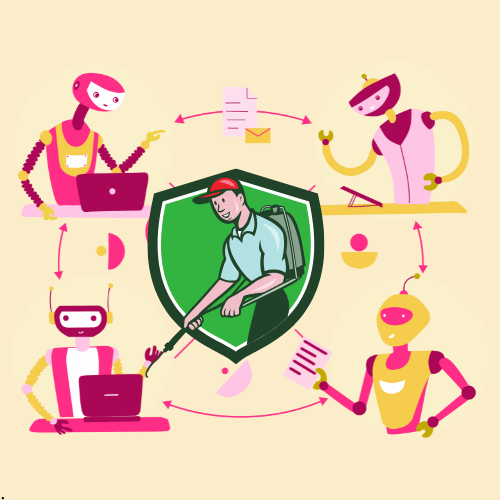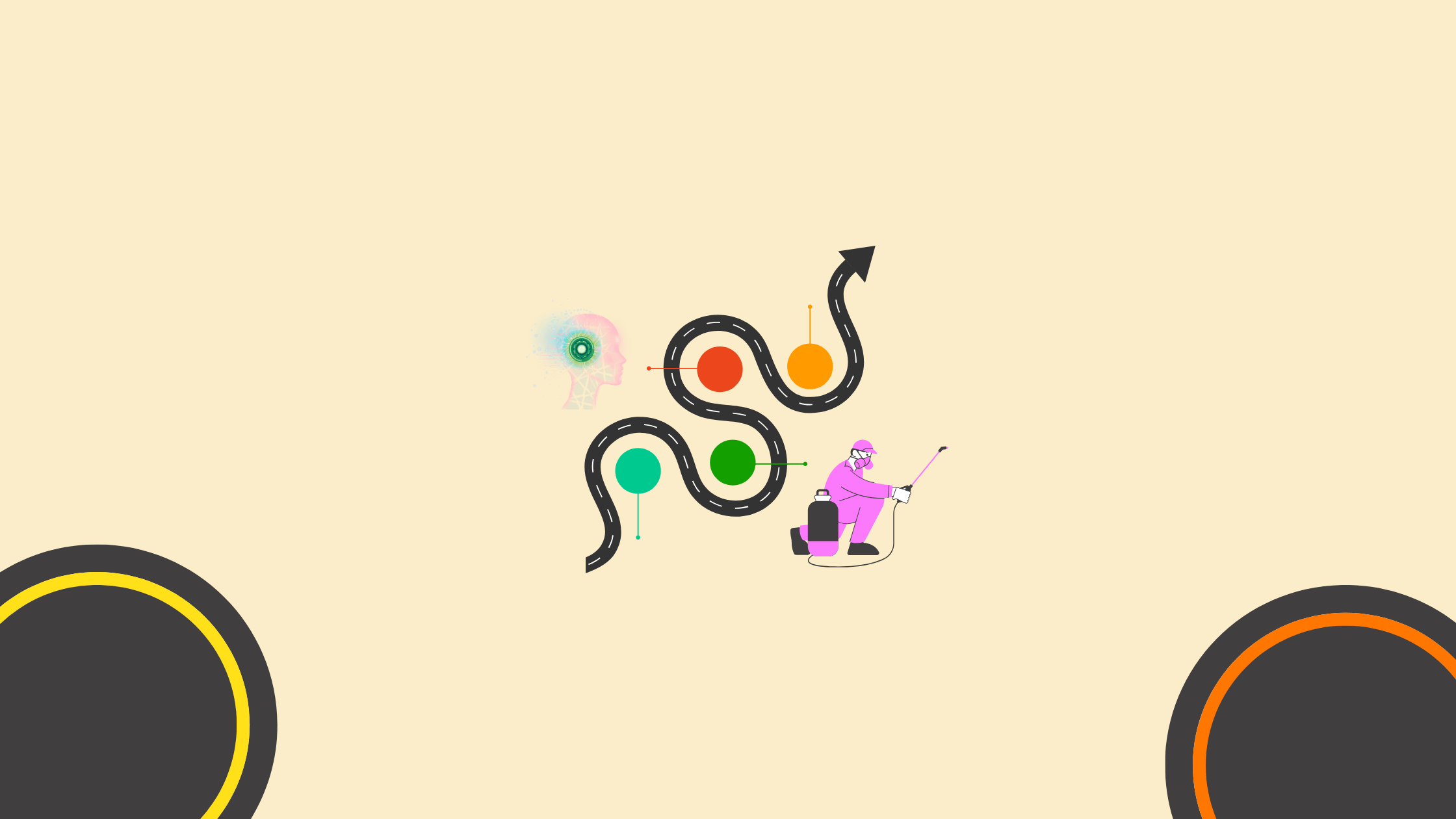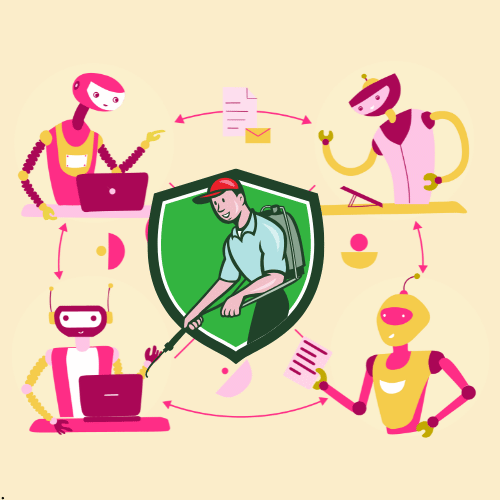AI Agents for Pest Control Companies [Get Started Today]

Pest control firms are juggling many demands: fast response times, legal/regulatory constraints (especially around pesticide use), customer expectations around safety and transparency, seasonal surges of pests, and rising environmental concerns.
Traditional methods, manual monitoring, reactive treatments, heavy administrative overhead, often fall short. AI agents offer opportunities to transform operations, from prevention through service delivery, while reducing costs and improving outcomes.
Want to get started with an AI Agent for your Pest Control Company today? Get the Marketing Manager in Your Pocket!
FieldSprout is like hiring a marketing manager, without the salary. The AI agents plan, write, and schedule ads, posts, and emails. You just approve by email and get back to running your crew.
Chapters
What Is an AI Agent in Pest Control?

An AI agent in this context can be any system with autonomy (or semi‑autonomy) that senses its environment, makes decisions, and performs tasks.
Components often include sensors (camera, sound, motion, even odor), computer vision, machine learning, NLP (for conversational agents), IoT, robotics, scheduling algorithms, and data analytics.
Types / Modalities
- Customer‑facing agents: chatbots, phone/voice agents handling inquiries, giving advice, booking appointments.
- Detection / Monitoring agents: camera traps with AI identification; sensors in structures; digital traps.
- Operational agents: scheduling / dispatch AI; voice assistants for field techs; automated reminders.
- Autonomous physical agents: robots or drones that inspect, monitor, or (in some cases) apply treatment.
Technologies Behind Them
- Computer Vision & Deep Learning: to identify pests or detect infestations from images.
- Predictive modelling / Machine Learning: forecasting outbreak risk based on environment, historic data, weather.
- Natural Language Processing (NLP): for dialogues, intake, and customer interactions.
- IoT & Edge Devices: traps, sensors, connected devices that feed data.
- Robotics & Navigation: for physical inspections or targeted treatment.
Use Case Illustrations
- Digital traps with sticky paper + camera + AI to count pest numbers and alert when thresholds exceeded. (Example: Scoutlabs’ digital trap network) Source.
- Autonomous mobile platforms inside greenhouses that detect early infestation and apply treatment only as needed. Source.
Why Pest Control Companies Are Adopting AI Agents
Let’s go deeper into the motivations and specific advantages, supported by recent findings.
| Benefit | Real‑World Evidence / Example | Implication for Pest Control Firms |
|---|---|---|
| Faster Response & Improved Lead Capture | AI appointment scheduling tools allow clients to book any time; reminders reduce no‑shows. | More leads converted; customers expect instant service, especially in pest emergencies. |
| Higher First‑Time Fix / Treatment Efficiency | AI scheduling in field service aligns technicians with jobs they are best equipped for—skills, location, and inventory—improving first visit success. | Reduces repeat visits, saves time and travel, increases revenue per job. |
| Reduced Costs & Better Resource Use | Automated routing and predictive scheduling save fuel, time, and technician idle hours. Monitoring systems reduce pesticide overuse by targeting only necessary areas. | Lower operational costs, reduced chemical use, less waste. |
| Environmental & Regulatory Compliance | AI traps offer early warnings so pesticide use only occurs when thresholds are exceeded. | Helps comply with regulations, reduces environmental impact, can be a selling point to eco-conscious customers. |
| Data‑Driven Decisions | Combining monitoring data, weather trends, and historical pest activity helps forecast outbreaks more accurately. | Enables better planning, proactive treatments, and more accurate quoting. |
| Customer Experience & Trust | AI agents handle inquiries 24/7, provide consistent information, and reduce customer wait times. | Builds trust, increases loyalty, drives referrals, and improves brand reputation. |
Real‑World Examples & Case Studies of AI Agents for Pest Prevention
Let’s check out some detailed case studies and examples, esp. in agriculture / pest control settings:
Scoutlabs (Hungary, UK, US)
They use an IoT‑based digital trap network. When insects get stuck on adhesive traps, images are taken, AI identifies the pest species or groups, gives alerts of pest pressure to farmers. Entomologists regularly review for accuracy. Data helps in forecasting and adjusting pesticide use. eitfood.eu.
Autonomous Mobile Platform in Greenhouses (Tekniker project, Spain)
A robot that moves inside greenhouse, detects pests early, and applies treatment only to the affected plants. It uses deep learning image databases, robotic arms, navigation systems. Aimed at reducing pesticide usage by targeting only where it’s needed. tekniker.es.
AgriHub, Malta
AI traps deployed across farms for monitoring five main crops. Data collection feeds an early warning system: farmers get green, yellow, or red signals based on pest threshold. Under Integrated Pest Management (IPM) guidelines, pesticides used only when needed. Europese Milieuagentschap.
Insect Population Prediction & Detection Study
In a greenhouse environment with black aphids, researchers used deep learning (YOLO variants) and time‑series models (ARIMAX etc) to predict insect populations. Achieved good accuracy, letting interventions be timed better. MDPI.
Challenges and Considerations Implementing AI Agents for Pest Control Companies
Let’s dig deeper into what companies need to watch out for, possible risks, how to mitigate them.
Data Quality & Bias
AI systems are only as good as their training data. Poor image quality, unbalanced datasets (e.g. more examples of some pest species than others), geographic or climate differences can reduce accuracy. Must gather local data or adapt global models.
Technical Complexity & Integration
Incorporating AI agents into existing workflows (field techs, admin staff, CRM, scheduling, equipment inventory) can be hard. Need APIs, possibly custom integrations. Without smooth integration, you can get duplication of work, silos, errors.
Cost, ROI & Hidden Expenses
Upfront costs: developing or buying AI tools; hardware (sensors, cameras, robots); training staff; maintaining the system. Also recurring costs: subscription fees, cloud compute, data storage, software updates. Must do cost‑benefit analysis. E.g. cost of AI appointment scheduling vs savings from fewer admin staff and better utilization.
Regulations, Safety, Liability
Use of pesticides is regulated; automated agents that recommend treatments must follow local laws. Also liability if AI misidentifies a pest or gives wrong treatment advice. For customer‑facing advice, need disclaimers and human oversight.
User Acceptance & Change Management
Staff may fear being replaced or misusing technology. Customers may prefer human interaction especially in stressful pest situations. It’s essential to provide training, be transparent, allow fallback to humans, gather feedback.
Maintenance & Continuous Improvement
Pest species evolve, environments change (e.g. climate shifts), customer expectations shift. AI systems need regular retraining, updating with new data, monitoring performance metrics (e.g., misclassification rates, customer satisfaction).
Best Practices for Implementing AI Agents for Pest Control

Detailed steps to get a successful deployment of AI Agents for your Pest Control Company.
Assess Needs & Define Use Cases Clearly
Do a gap analysis: where are inefficiencies or customer pain points? For example, is appointment booking slow? Are technicians traveling inefficient routes? Is pesticide usage too high or complaints frequent? Prioritize use cases that give high impact, relatively low risk, and clear measurement.
Pilot Projects / MVPs
Don’t try to do everything at once. Build a minimum viable version of an AI agent in one area (e.g. a chatbot for after‑hours booking, or digital trap in one region) to test, collect data, see what works.
Collect & Curate Data
High quality images, sensor readings, pest species labels, environmental data, weather, soil, structure types. If possible, involve domain experts (entomologists or technicians) to verify classifications and human‑in the loop.
Choose the Right Tools & Partners
Off‑the‑shelf vs custom: sometimes existing platforms suffice; sometimes need custom AI models especially for detection or robotics. Evaluate vendors for reliability, support, local customization, privacy.
Ensure Integration & Workflow Alignment
Make sure AI agent integrates with the CRM, scheduling tools, field‑tech mobile apps, invoicing, etc. Ensure techs in the field receive correct and timely information (e.g., job prep, pest type, materials needed).
Define Metrics & Monitor
What will success look like? Potential metrics: lead conversion, response time, no‑show rates, first‑time fix rate, pesticide use per job, cost per job, customer satisfaction, environmental metrics. Use dashboards, logs, feedback channels.
Train Staff & Customers
Staff: how to use the tools, how to override or correct them, how to provide feedback to improve. Customers: make clear when they are interacting with AI, how to escalate to human, what information will be collected, privacy.
Iterate & Improve
Use feedback loops: technician feedback on misclassification or false positives/negatives; customer feedback; data drift over time. Plan for periodic retraining, updating models; maintain hardware; fix bugs.
Compliance & Ethical Guidelines
GDPR/data privacy, safety regulations for pesticide use, any local licensing, transparency. Include human oversight especially in decision points that have health or safety impact.
Future Trends – What’s Next – AI Technology in Pest Control
Looking ahead at emerging developments and technologies.
Robotics & Autonomous Systems
Robots that can inspect, monitor, and treat pests with precision (inside greenhouses, in crops, in infrastructure). Drones or autonomous ground vehicles. E.g., mobile robot platforms inside greenhouses.
Remote Sensing, Satellite & Drone‑Based Monitoring
Using multispectral imaging, drones to cover large areas, identify pest stress signals before visible damage. Helps scale monitoring for large farms or regions.
Tiny AI and Edge Computing
Running models on small devices (traps, cameras) so detection happens locally, reducing latency, dependency on network, and possibly improving privacy. Studies show detection of pests with lightweight models embedded on IoT devices.
Predictive & Prescriptive Analytics
Not just detecting pests, but forecasting pest outbreaks using weather, crop data, pest population trends, enabling preventive actions. Also optimization of treatment schedules, resource allocation.
Personalized and Customer‑Centric AI
Agents that can tailor recommendations based on customer history, complaints, building structure, previous pest issues; enhanced conversational interfaces; mobile apps for customer self‑reporting with image uploads.
Sustainability & “Green” Pest Control
Pressure from consumers, regulators to reduce chemical usage; AI helping in precise targeting, reducing pesticide runoff; more adoption of integrated pest management (IPM) aided by AI.
Regulatory & Standardization Movements
Likely more guidelines / standards around AI in pest control—how data must be collected, safety protocols, accuracy benchmarks, perhaps certifications for AI tools in this field.
Cost Structure & ROI Modelling
How to calculate the return on investment, what costs to expect, what factors to include, with examples.
Components of Cost
- Development / acquisition of AI software / agents
- Hardware: sensors, cameras, traps, robotics equipment, mobile devices
- Integration with existing systems (software & workflow)
- Training staff & customers
- Ongoing maintenance, support, updates, cloud compute / data storage, retraining models
- Regulatory compliance, safety testing, liability coverage
Revenue / Savings Streams
- Increased lead conversion and faster response = more jobs
- Reduced travel, optimized routes = fuel, time saved
- Fewer repeat visits / higher first‑time fix rate
- Lower pesticide / chemical usage
- Fewer administrative staff hours or overtime
- Reduced liability or regulatory fines if compliance is improved
ROI Modelling Example
- Suppose a mid‑sized pest control company with 50 techs deploys AI scheduling + digital traps:
- Costs in year 1: software subscription ($X), hardware ($Y), training & setup ($Z)
- Savings: reduced travel costs 10%, reduced pesticide use 20%, admin labor saved 2 full‑time equivalents, increase in jobs from better lead capture etc.
- Break‑even estimation: when savings exceed cumulative cost; then net benefit in later years.
Key Sensitivity Factors
- Scale: larger size tends to spread fixed costs thinner
- Local pest species diversity: some areas require more training, more hardware
- Data availability and quality: impact on model accuracy
- Seasonality: need to ensure during off‑peak times the system’s cost is still justified
Risk Adjustments
- Plan for failure / misidentification – potential cost of mistakes
- Overestimating uptake among customers or staff resistance
Legal, Ethical & Environmental Considerations
Ensuring your AI agent work is safe, legal, trustworthy, and sustainable.
Regulatory Compliance
- Pesticide regulations vary by region (which pests, what chemicals, when, how applied)
- Local laws may require licensed applicators, disclosure to customers
- Data privacy / GDPR (in EU): storage of image data, customer data, recordings
Ethics & Transparency
- Be clear to customers when AI is in use, when a human is involved
- Use disclaimers around advice given by AI, especially when health or structural damage is possible
- Fairness: ensure AI models don’t systematically misidentify certain species (or bias geographic areas)
Environmental Impact & Sustainability
- Reducing chemical use via precise targeting, early detection
- Minimizing environmental runoff, non‑target species harm
- Renewable energy / low‑power sensors, reducing carbon footprint of operations
Liability & Risk Management
- What if AI misclassifies a pest, leading to ineffective treatment or damage? Who is responsible?
- Insurance considerations: covering errors, property damage, allergic reactions to pesticide etc.
- Safety protocols for robots / drones: ensuring they avoid harming people or pets
Customer Privacy & Consent
- If using cameras on customer property, getting consent, handling video/image data securely
- Clear policies of how long data is stored, who can access it
Implementation Roadmap (Step‑by‑Step Practical Guide)

A hands‑on guide for a pest control company to plan and roll out AI agents in stages.
Discovery & Strategy Phase
- Stakeholder interviews (owners, technicians, admin, customer service) to understand pain points
- Competitive & market analysis: what competitors are using, what customers expect
- Define clear goals / metrics (KPIs) e.g. reduce travel cost by 15%, double lead conversion, reduce chemical use, etc.
Pilot / MVP Phase
- Select one use‑case (e.g. digital trap in one region, AI scheduling for a certain route, chatbot for after‑hours calls)
- Build or procure minimal system; test in controlled way
- Monitor performance: accuracy, user feedback, cost vs benefit
Scaling Phase
- Based on pilot feedback, refine tools, address weaknesses (data gaps, misclassification, integration challenges)
- Expand deployment to more regions or service lines
- Train more staff; create documentation & internal support
Integration & Workflow Adjustment
- Integrate with CRM, mobile apps for techs, billing, inventory, customer notification systems
- Ensure field staff receive correct AI‑generated info (e.g. pest type, required tools, safety protocol)
- Adjust scheduling and logistic workflows to benefit from optimized routing and first‑time fix logic
Monitoring & Continuous Improvement
- Maintain dashboards: tracking KPIs over time
- Collect feedback from front‑line technicians and customers
- Retrain AI models, especially for detection tasks, to adapt to new pests or conditions
Maintenance & Support
- Hardware upkeep, sensor calibration, camera cleaning etc.
- Software updates, security patches, data backups
- Support channels for techs / staff to report issues
Review & Reassessment
- Annual or semi‑annual reviews: cost savings vs projections, customer satisfaction, operational changes
- Consider new technologies or trends to adopt (e.g. new sensors, drone inspection)
Conclusion
AI agents offer pest control companies powerful tools to transform the business: enabling proactive pest management, reducing costs, enhancing customer satisfaction, and improving environmental sustainability.
But success depends on thoughtful planning, strong data, legal and ethical compliance, and continuous improvement. By following a staged roadmap and measuring what matters, companies can ensure they gain meaningful returns from their AI investments.
FAQ AI Agents for Pest Control Companies
Each is designed to align with common search intent and improve your chances of showing up in Google’s “People Also Ask” section.
What is an AI agent in pest control?
An AI agent in pest control is a digital system, like a chatbot, sensor-based monitor, or scheduling tool, that automates tasks such as appointment booking, pest detection, or data analysis.
Can AI replace pest control technicians?
No. AI enhances technicians’ work by automating routine tasks and improving detection accuracy, but it doesn’t replace the hands-on expertise required for treatments and inspections.
How does AI detect pests?
AI detects pests using sensors, cameras, and image recognition models trained to identify specific insects or signs of infestation. These systems can alert teams in real time.
Is AI in pest control expensive to implement?
Costs vary, but most companies start with small-scale tools like AI call agents or digital traps. Over time, savings in labor, chemicals, and travel often outweigh the initial investment.
What are the benefits of using AI in pest control?
Key benefits include faster response times, reduced pesticide usage, optimized technician scheduling, 24/7 customer support, and improved treatment success rates.
Is AI safe and legally compliant for pest control?
Yes, when properly implemented. AI systems must follow safety guidelines, pesticide regulations, and data privacy laws such as GDPR if used in the EU.
Can AI help reduce pesticide usage?
Absolutely. By detecting pests early and targeting treatments precisely, AI can reduce unnecessary chemical use, supporting more sustainable and environmentally friendly pest control.
Other Interesting Articles
Master the Art of Video Marketing
AI-Powered Tools to Ideate, Optimize, and Amplify!
- Spark Creativity: Unleash the most effective video ideas, scripts, and engaging hooks with our AI Generators.
- Optimize Instantly: Elevate your YouTube presence by optimizing video Titles, Descriptions, and Tags in seconds.
- Amplify Your Reach: Effortlessly craft social media, email, and ad copy to maximize your video’s impact.
The post AI Agents for Pest Control Companies [Get Started Today] appeared first on StoryLab.ai.


Deixe um comentário